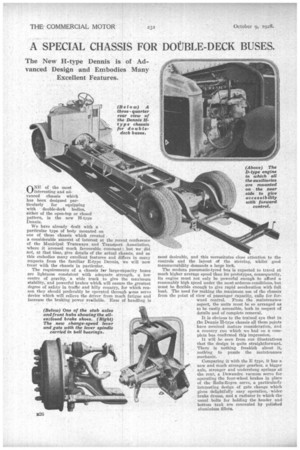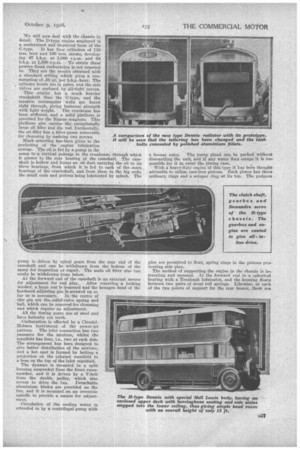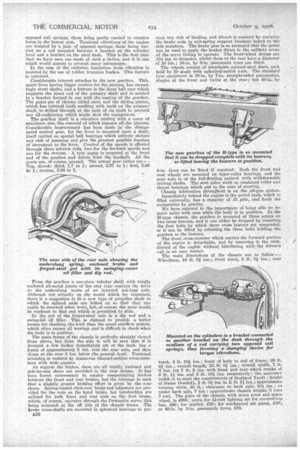A SPECIAL CHASSIS FOR DOCBLE-DECK BUSES.
Page 10

Page 11

Page 12

If you've noticed an error in this article please click here to report it so we can fix it.
The New H-type Dennis is of Advanced Design and Embodies Many Excellent Features.
1-11NE of the most k.linteresting and advanced chassis which has been designed particularly for equipping . with double-deck bodies, either of the open-top or closed • pattern, is the new H-type Dennis.
We have already dealt with a particular type of body mounted on
one of these chassis which ,created , • a considerable amount of interest at the recent conference of the Municipal Tramways and Tranaport Association, where it aroused much favourable comment ;•• but we did not, at that time, give details of the actual chassis, and as this embodies many excellent features and differs in many re!spects from the familiar E-type Dennis, we will now treat with the chassis in particular.
The requirements of a chassis far large-capacity buses are lightness consistent with adequate strength, a low centre of gravity, a wide track to give the maximum stability, and powerful brakes which will ensure the greatest degree of safety in traffic and hilly country, for which reason they should preferably be operated through ;Gine servo device which will relieve the driver from much fatigue and increase the braking power available. Ease of handling, is most desirable, and this necessitates close attention to the controls and the layout of the steering, whilst'. good manmuvrability,demands a large lock.
The modern pneumatie-tyred bus is expected to travel at much higher average speed than its prototypes, consequently, its engine must not only be powerful enough to afford a reasonably high speed under the most arduous conditions, but Insist be flexible enough to give rapid acceleration with full load. The need for making the .maximum use of the' chassis from the point of view of passenger capacity, calls for for
ward control. From the maintenance aspect, the units must be so arranged as to he easily accessible, both in respect of details and of complete removal. .
It is obvious to the trained eye that in the Dennis H-type chassis all these points have received mature consideration, and a country run which we had on a complete bus confirmed this impression.
It will be seen from our illustrations that the design is quite straightforward. . There is nothing freakish about it; nothing to puzzle the maintenance mechanic.
Comparing it with the E type, it has a new and much stronger gearbox, a bigger axle, stronger and umlerslung springs at the rear, a Dewandre vacuum servo for operating the four-wheel brakes in place of the Holls-Royce servo, a particularly
interesting design of gate change which• gives delightfully easy operation, wider.
brake drums, and a radiator in which the • usual bolts for holding the header andbottom tank are concealed by polished aluminium fillets. • . We will now deal with the chassis in detail. The D-type engine employed is a modernized and improved form of the
C-type. It has four cylinders of 110 mm. bore and 150 mm. stroke, developing 47 b.h.p. at 1,000 r.p.m. and 04 b.h.p. at 1,590 'r.p.m. _ To obtain theW powers freak carburation is not resorted to. They are the results obtained with a standard setting which gives a consumption'of .58-pt. per b.h,p.-hour. The cylinder heads are in pairs, and the side valves are .enclosed by oil-tight covers.
This engine has a much heavier crankshaft than the C-type, and the massive rectangular webs are bored right through, giving immense' strength with light weight. The crankcase has been stiffened, and a solid platform is provided for the Simms magneto. This platform also carries the exceptionally large oil filler end dip rod. Incidentally, the oil filler has a filter gauze removable for cleansfeg by undoing two screws.
Much attention has-been given to the perfecting of the engine lubrication system. The oil. is fed by a pump in the sump to a vertical passage in the crankcase; through which it passes to the rear bearing of the camshaft. The camshaft is hollow and forms an oil duct carrying the oil to its three bearings, from which it is fed to each of the main. bearings of the crankshaft, and from these to the big ends, the small ends and pistons being lubricated by splash. The
pxmp is driven by spiral gears from the rear end of the camshaft and can he withdrawn from the boitom of the sump for inspection or repair. The main oil filter also can easily be withdrawn from below.
All the timing gears are of steel and have helically cut teeth.
Carburation is effected by a ClaudelHobson instrument of the power-jet pattern. The inlet connection has two passages for the mixture, whilst the manifold has four, i.e., two at each side. The arrangement has been designed to give better distribution of the mixture, and a hot spot is formed by bolting a projection on the exhaust manifold to a boss on the top of the inlet manifold.
The dynamo is mounted in a split housing suspended from the front cross member, and it is driven by a V-belt from the double pulley, which also serves to drive the fan. Detachable aluminium blades are provided on the fan, and it is mounted on an eccentric spindle to provide a means for adjustment.
Circulation of the cooling water is attended to by a centrifugal pump with
a bronze rotor. The pump gland can be packed without dismantling the unit, and if any water does escape it is imPossible for it to enter the timing case. _
' With a heavy-duty engine Of this type it has been thought advisable to utilize cast-iron pistons.Hach piston has three ordinary /ins and a scraper ring at its top. The gudgeon
pins are permitted to float, spring rings in the pistons preventing side play.
The method of supporting the engine in the chassis is interesting and unusual. At the forward end is -a spherical bearing with a Teealemit lubricator, and the housing floats between two pairs of stout coil springs. Likewise, at each of the two points of support for the rear bearer, there are
opposed coil springs, these being partly carried in counter bores in the bearer arm. Torsional vibrations of the engine are resisted by a pair of opposed springs, these being carried on a rod mounted between a bracket on the cylinder head and a bracket on the steel dash. This is the first time that we have seen use made of such a device, and it is one which would appear to present many advantages. In the case of the radiator, insulation from vibration is assisted by the use of rubber trunnion bushes. This feature is patented.
,Considerable interest attaches to the new gearbox. This, apart from having bigger centres for the pinions, has exceedingly stout shafts, and a feature is the large ball race which supports the inner end of the primary shaft and is carried in a bracket formed in one with the casting of the gearbox. The gears are of chrome nickel steel, and the sliding pinion, which has internal teeth meshing with teeth on the primary shaft, is drilled through at the ends of its teeth to prevent any oil-cushioning which might slo* the engagement.
The gearbox itself is a one-piece casting with a cover of maximum size,-the removal of which exposes all the pinions. Considerable improvement has been made in the changespeed control gear, for the lever is mounted upon a shaft, itself carried on special ball bearings which entirely obviate any risk of jamming and give the greatest possible freedom of movement to the lever. Control of the speeds is effected through three selector rods, two -for the forward speeds and one for the reverse. A tyre pu,mp is mounted at the front end of the gearbox and driven from the layshaft. All the gears are, of course, ground. The actual gear ratios are:— Top, direct; third, 1.7 to 1; second, 2.97 to 1; first, 5.06 to 1; reverse, 5.06 to 1.
From the gearbox a one-piece tubular shaft with totally enclosed all-metal joints of the star type conveys the drive to the underslung worm of an inverted pot-type axle. Although not actually on the model which we examined, there is a suggestion to fit a new type of propeller shaft in which the splined ends are bolted on so that they can easily be renewed when worn, but, of course, the wear would be confined to that end which is permitted to slide.
In the pot of the forged-steel axle is a dip rod and a swing-lid oil filler. This is claimed to provide a better means for checking the level than the usual overflow system, which often causes Oil wastage and is difficult to check when the body is in position.
The main frame of the chassis is perfeetly straight viewed from above, but from the side it will be seen that it is dropped a few inches immediately aft of the dash, has a hump of approximately 5 ins, over the rear axle, and then drops at .the rear 8 ins, below the general level. Torsional stressing is resisted by numerous channel-section crosS-inernhers with wide gussets.
As regards the brakes, these are all totally enclosed and side-by-side shoes are provided in the rear drums. It has been found unnecessary to employ compensating device's between the front and rear brakes, but the leverage is such that a slightly greater braking effect is given by the mix shoes. Spring-loaded click-over brake-rod adjusters are provided for the rods on the hand brake, but turnbuckles are utilized for both front and rear rods on the foot brake, which, of course, operates through the Dewandre servo, this being mounted at the off side of the chassis frame. The brake cross-shafts are mounted in spherical bearings to pre 1328 vent any risk of binding, and silence is ensured by carrying the brake rods in coil-spring support brackets bolted to the side members. The brake gear is so arranged that the pedal can be used to apply the brakes direct in the unlikely event of the servo failing to operate. The front-wheel drums are 18 ins, in diameter, whilst those at the rear have a diameter of 20 ins.; 38-in. by 8-in, pneumatic tyres are fitted.
The wheels consist of detachable pressed-steel discs, each held by 10 studs with spherical-seated nuts. The standard tyre equipment is 38-in. by 7-in, straight-sided pneumatics, singles at the front and twins at the rear; but 40-in. by 8-in. tyres can be fitted if required. Both the front and rear wheels are mounted on taper-roller bearings, and the rear axle is of the full-floating patterrl with withdrawable driving shafts. The stub axles work on combined roller and thrust bearings which add to the ease of steering.
Chassis lubrication throughout is on the oil-gun system.
Immediately behind the engine is the petrol tank, which is filled externally, has a capacity of 33 gals., and feeds the carburetter by gravity.
We have referred to the importance of being able to remove units with ease while the body is in position. In the H-type chassis, the gearbox is mounted at three points on two cross bearers, and it can either be dropped by removing the four bolts by which these cross bearers are suspended, or it can be lifted by releasing the three bolts holding the gearbox to the bearers. The front cross-member which carries the forward portion of the engine is detachable, and by removing it the withdrawal of the engine without interfering with the driver's cab is an easy matter.
The main dimensions of the chassis are as follow:— Wheelbase, 16 ft. 61 ins.; front track, 6 ft. 5i ins.; rear
track, 5 ft. 10i. ins.; front of body to end of frame, 20 ft. Oi ins.; overall length, 25 ft. 0a ins.; overall width, 7 it. 6 ins. (or 7 ft. 2-ins, with front and rear wheel tracks of
6 ft. 1.1ins. and 5 ft. 101c ins. respectively ; the narrower width is to Meet the requirements of Scotland Yard) ; height of frame (loaded), 2 ft. 01 ins. to 2 ft. ins. ; approximate turning circle, 55 ft. ; clearance to back axle, 10i ins.; to under back axle, 7 ins.; approximate chassis weight, 3 tons 7 cwt. The price of the chassis, with seven tyres and spare wheel, is £995; extra for 12-volt lighting set for covered-top bus, £00; for starter, £20; for mechanical air pump, £10; or 40-in. by S-in, pneumatic tyres, £30.
































